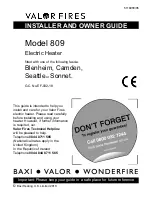
LP-436 Rev. 5.20.15
19
B. Drafthood Operation
The higher the temperature setting, the greater the risk of
scalding. Hot water can cause third degree burns in 1 second
at 160
o
F (71
o
C), 5 seconds at 150
o
F (65
o
C), and 30 seconds at
130
o
F (54
o
C). In households where there are children, physically
challenged individuals, or elderly persons, mixing valves for
point of use are necessary as a means of reducing the scalding
potential of hot water. Failure to install a mixing valve can result
in serious personal injury or death.
It is important to check that the ventilation system is working
properly once the water heater main burner has been lit. Wait
10 minutes after lighting the burner. Then introduce a match
or candle around the opening of the drafthood. If the flame is
drawn towards the opening, this indicates proper ventilation.
If the flame flutters or is blown out, combustion gases are
escaping from the drafthood opening. If this occurs, shut the
water heater off immediately and locate the problem.
Do
not try and operate the water heater again until you are
satisfied that the problem has been corrected.
C. Water Temperature Regulation
The water temperature
for all models is
controlled
by
a
thermostat with two
sensing elements. One
sensor is located near
the top of the tank and
the other is near the
center. The thermostat
is factory adjusted to
its lowest temperature
setting. To adjust the
water
temperature,
insert a small flat head
screwdriver into the
slotted screw located
in the hole on the front
of the thermostat. See
Figure 18. Turn the
temperature dial to
the desired setting. To maximize
the efficiency of the water heater
and reduce the risk of scalding, it
is recommended that the dial be
adjusted to the lowest setting that
produces an acceptable hot water
supply. The dial may be set from
100
o
F to 180
o
F (38
o
C to 82
o
C).
When hot water is drawn from
the tank in frequent short bursts,
a condition known as “stacking”
is created. “Stacking” is the result
of increased cycling of the burner
and can produce very hot water
temperatures at the hot water
outlet. Always remember to check
the hot water coming out of any
faucet with your hand before use.
This will reduce the risk of scalding
related injury.
Figure 18 - Thermostat
D. Out of Fuel
Should overheating occur or the gas supply fail to shut off,
close the gas supply manual shut-off valve. Failure to follow this
instruction can result in serious personal injury or death.
If your water heater should run out of gas, proceed as follows:
1. Set the thermostat to the lowest setting.
2. Turn the gas control knob clockwise to “OFF”.
3. Turn off all electric power to the appliance.
4. Once the gas supply has been reestablished, proceed to
Lighting Instructions
.
A. Housekeeping
DO NOT STORE or use gasoline or other flammable vapors or
liquids around the water heater.
DO NOT BLOCK or in any way restrict the flow of fresh air to the
water heater.
DO NOT PUT or store any objects on the top of the water heater.
Failure to follow these instructions can result in property
damage, personal injury, or death.
Part 4 - General Maintenance
Keep the area around the water heater clean and free of dust,
lint, and dirt. Vacuum any dirt as required. Make sure that all
of the minimum clearances to combustible materials are being
maintained.
B. Condensation
As moisture from the products of combustion comes in contact
with the cold surface of the inner tank, it may condense. This
situation will usually occur:
• When the water heater is filled with cold water for the
first time.
• If the water heater has been undersized.
• When large amounts of hot water are drawn from the
water heater in a short period of time, and the refill water
is very cold.
Due to the efficiency rating of this gas-fired water heater, it may
produce more condensation than previous water heater models.
Condensation forming on the flue tubes will drop on the burner,
making a “sizzling” sound. In extreme cases, the condensate
may even extinguish the pilot flame. This condition is not
uncommon and must never be misinterpreted as a leaking tank.
Excess condensation will disappear once the water becomes
heated.
Because of the large amounts of water that can condense,
it is very important that a drain pan be installed under the
water heater. Refer to Figure 13.
Under no circumstances is
Содержание CG N65 Series
Страница 17: ...LP 436 Rev 5 20 15 17 Figure 17 Wiring the Control...
Страница 24: ...LP 436 Rev 5 20 15 24...
Страница 25: ...LP 436 Rev 5 20 15 25...
Страница 26: ...LP 436 Rev 5 20 15 26...
Страница 27: ...LP 436 Rev 5 20 15 27...
Страница 28: ...LP 436 Rev 5 20 15 28...
Страница 33: ...LP 436 Rev 5 20 15 33 Maintenance Notes...
















































